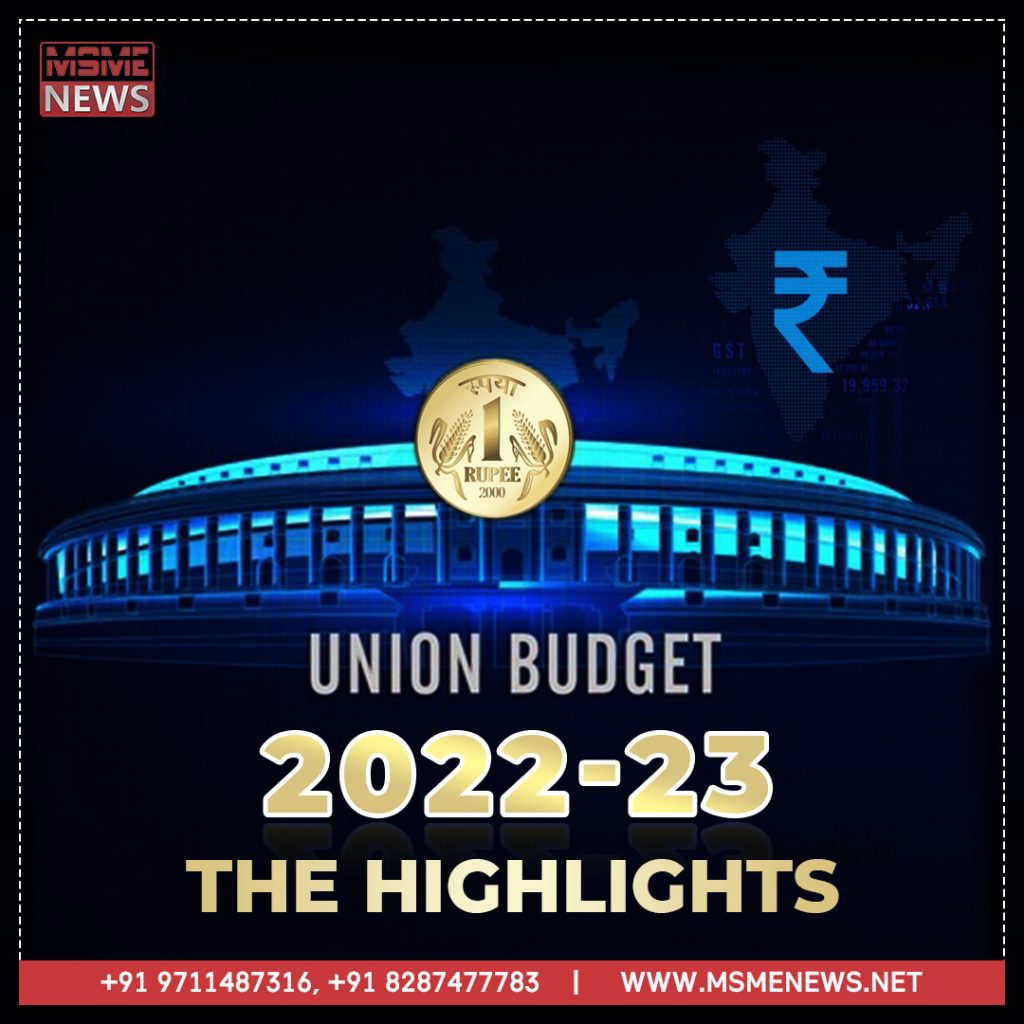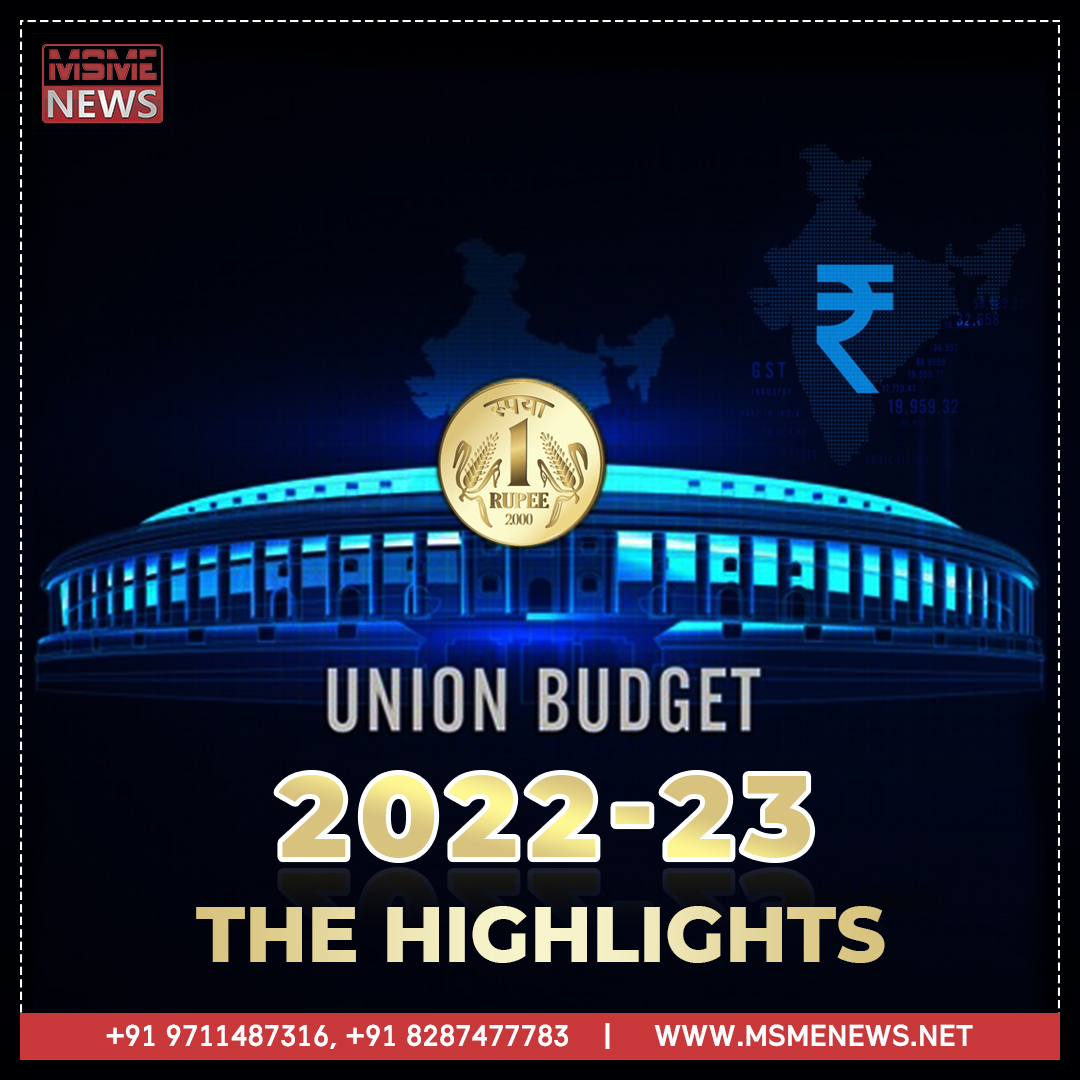
Finance Minister of India Nirmala Sitharaman tabled the fourth Budget of the Modi 2.0 government for the fiscal year 2022-23. This budget is centred on health and well-being, infrastructure, inclusive development, investment financing, energy transition and climate action. While presenting the budget in the parliament, the finance minister stressed ‘Minimum Government, Maximum Governance and announced India’s economic growth prediction to be the greatest among all large economies, at 9.2 per cent. She stated 60lakh new jobs will be created in 14 secto₹, under the productivity-linked incentive scheme.
Among some major announcements include digital currency, e-passports, and large scale infrastructure projects. Edible oil, wearable electronics, replica jewellery, and polished diamonds will get a little cheaper. For pe₹ons with disabilities, there will be the provision of tax reduction. No announcements of any changes to pe₹onal income tax rates.
Here are the key highlights of the Union Budget 2022-23:
Expenditure and deficit
• The budget has proposed a fiscal deficit of 4.5% of GDP by 2025-26.
• The budget deficit is expected to be 6.4 per cent of GDP in 2022/23.
• The budget deficit of 6.9% of GDP is estimated for 2021/22
• For states, authorized 50-year interest-free loans over and above standard borrowing
• The scheme for financial support to states for capital expenditure outlay will be ₹ 1lakh crore in 2022-23
• Disinvestment profits receipts for the next financial year are expected to be ₹ 65,000crore, down from the current year’s mobilization of ₹ 78,000crore.
Agricultural sector
• An efficient plan to improve domestic oilseed production will be implemented to reduce the burden of imports
• The government will pay ₹ 2.37 lakh crore under MSP operations for wheat and paddy procurement
• Kisan drones for crop evaluation, land records, and insecticide spraying with an objective to create a wave of technology in the agricultural industry
• Announcement of Ken Betwa river connection project with an estimated cost of ₹ 44,605 crores.
• The drafts of DPRs for five river linkages have been completed.
• Natural farming to be promoted along the Ganga river corridor.
• Government to promote chemical-free natural farming across the country to enhance agricultural output and income.
• Small farmers and MSMEs to get the benefits from new railway products.
• NABARD will assist the setup of a co-investment fund to finance agriculture and rural enterprise start-ups that are related to the farm produce value chain.
• Proposal for finance start-ups as a means of assisting rural businesses.
• Ministries for procurement will establish an entirely paperless, e-bill system.
• Farmers will be given financial assistance to start agroforestry.
Digital asset
• Virtual digital asset income will be taxed at a rate of 30%.
• Losses resulting from the sale of virtual digital assets cannot be compensated by other sources of income.
• Taxation structure will be introduced for virtual digital assets
Educational sector
• A new portal to encourage a digital ecosystem for skilling and livelihood, DESH-stack e-portal will be launched in several Indian languages
• Proposal to increase One Class, One TV channel from 12 to 200 channels, to compensate for the loss of formal education due to COVID-19. It will give supplementary education in all regional languages.
• Central government is aiming to renovate the National Skill Qualification Framework (NSQF) that will be aligned with dynamic industry needs.
• States to be encouraged to revise the syllabus of agricultural universities to meet needs of natural, zero-budget & organic farming, modern-day agriculture.
Finance status
• All 1.5lakh post offices to be moved on the core banking system, allowing for financial inclusion and account access through online banking, mobile banking, ATMs, and other means.
• Proposal for the introduction of the digital rupee by RBI using blockchain technology in 2022-23.
• Efforts will be made to increase private capital in the infrastructure sector.
• Amendments in IBC to enhance the efficiency of the resolution process
• Facilitate cross-border insolvency resolution
• To encourage digital payments, 75 digital banks in 75 districts will be set up by scheduled commercial banks
• International arbitration centre to be set up in GIFT city to provide faster dispute resolution
• World-class university to be allowed in GIFT IFSC free from domestic regulation.
•
Defence sector
• Private industry will be encouraged to take up the design and development of military equipment and platforms in collaboration with DRDO and other organizations through the SPV model.
• The government is committed to reducing imports and promoting self-reliance in the defence sector, with 68% of capital allocated to the domestic industry.
• Proposal for 68 per cent of the defence capital procurement budget in 2022-23 to be allocated to domestic industry (up from the 58 per cent last fiscal)
Infrastructure
• Contracts for four multi-modal national parks to be awarded in the fiscal year 2022-23
• PM Gati Shakti master plan for expressways will be formulated in the next financial year
• 100 PM Gati Shakti terminals to be set up in next three years
• Focus on public investment to modernize infrastructure over the medium term, leveraging the tech platform of Gati Shakti through a multi-modal approach.
Telecom
• Auctions for 5G spectrum to be held in 2022.
• The production-linked strategy will include a design-led manufacturing scheme for 5G.
• Contracts for the installation of optical fibre in rural areas will be awarded, with a completion date of 2025.
Taxation reliefs
• Extension for the duty-free status of steel scrap for small and medium-sized firms for another year
• Stainless steel, flat items, and high steel bars will no longer be subject to customs duties.
• Unblended petrol will be subject to a 2 rupee per litre surcharge from October 2022
• Certain chemical import duties are being decreased.
• For state govt employees, tax deduction limit increased to 14% on employer’s contribution to NPS account
• For cooperative societies, Alternate Minimum Tax to be cut to 15%. This will reduce the surcharge on cooperative societies to 7%, for those whose income is between Rs 1 crore and Rs 10 crore
Economy status in terms of final budget
• Micro-all-inclusive welfare, digital economy and biotech, tech-enabled development, energy transformation, and climate action are all aimed at complementing macro-growth.
• Capex target has increased by 35.4 per cent from ₹5.54 lakh crore to ₹ 7.50 lakh crore. The effective capex for the fiscal year 2022-23 is expected to be ₹ 10.7 lakh crore.
Housing & Urban Planning
• Allocation of ₹48,000 crores for PM Awas Yojana
• In 2022-23, 80lakh houses to be completed under PM Awas Yojana beneficiaries. 60,000 houses will be identified as PM Awas Yojana beneficiaries in rural and urban areas
• Allocation of ₹60,000 crores for providing 3.8 crore households with access to tap water
• 80 lakh households will be identified for the affordable housing scheme in 2022-23
• Planning to set up a high-level committee for urban planners and economists for recommendations on urban capacity building, planning implementation, and governance
Conclusion
Experts see this budget as a capital expenditure-driven budget meant to restore the COVID-hit economy. It aims to create more job opportunities and generate revenue while developing the infrastructure and improving the GDP for a stable Indian economy.
For more updates, stay tuned to MSME News.



